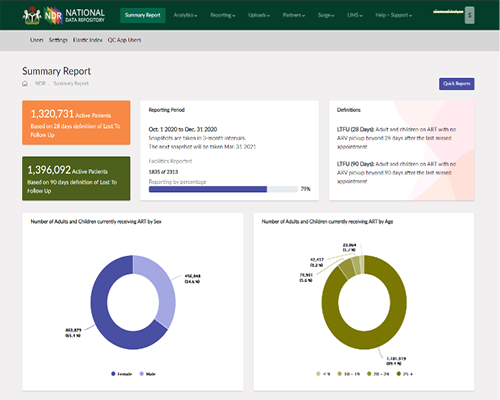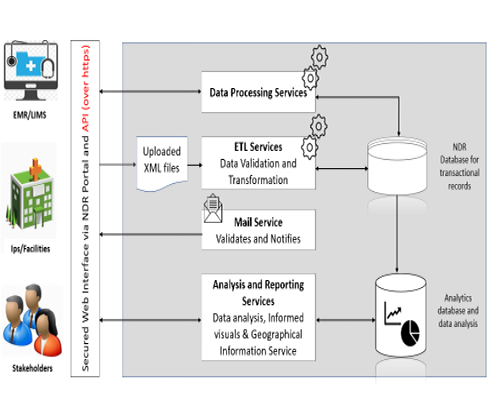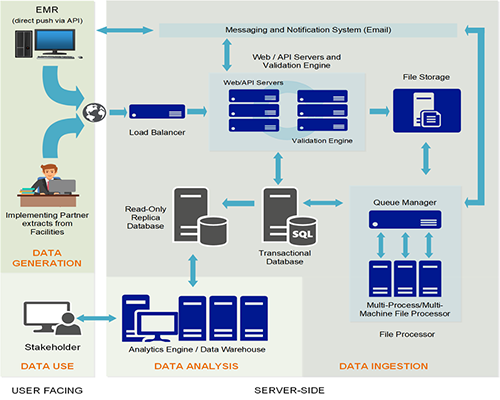Nigeria National Data Repository (NDR)
The University of Maryland, Baltimore (UMB) played a critical role in developing the Nigeria National Data Repository (NDR) to support HIV surveillance, research, and program management in Nigeria. The NDR was created to help achieve the Joint United Nations Programme on HIV/AIDS (UNAIDS) 95-95-95 target by providing reliable and timely data. Prior to the introduction of the NDR, paper-based data systems had been replaced with facility-level electronic medical record (EMR) systems, but there was no national central system in place to collate data at the national level. The UMB SHIELD project, funded by the United States Centers for Disease Control and Prevention (CDC) Nigeria, developed the NDR, as a unified storage repository of de-identified patients, to create a central HIV data warehouse that merged patient-level data across all HIV healthcare facilities in the country.

The NDR has the potential to support surveillance, program evaluation, and program monitoring towards achieving HIV epidemic control in Nigeria. The quality of data uploaded to the NDR has improved over time, and the fingerprint template data in the NDR has allowed for the de-duplication of records among PLHIV who may receive HIV treatment at multiple healthcare facilities. The NDR's user-friendly dashboards are used to support program management data use needs, with automated analytics that disaggregate data by sub-population and programmatic levels.
The NDR facilitates the availability of data for patient-level tracking and monitoring across systems through the integrated HIV case-based surveillance system. Built-in longitudinal analysis, including the Case Base Surveillance, is included in the NDR, and data can also be exported to other tools for additional analysis not included in the NDR analytics. The NDR also includes HIV recent infection surveillance data that supports the monitoring of preliminary recent and confirmed recent infection using the Recent Infection Testing Algorithm (RITA). To facilitate the creation of de-identified analytical datasets, a snapshot of the data was momentarily taken. This enables the datasets to be stored in a separate analytical database, providing researchers with a secure platform to access the specific datasets they need for their studies.

The NDR (Nigeria National Data Repository) is built on a three-tier architecture: client layer, application layer, and data management layer. The client layer allows users to upload data to the NDR through a web interface and features functionality for querying across clients' records and aggregate data. The application layer consists of the queue manager, data validation engine, and an analytic engine. The data management layer houses all reported data, including patient demographic and fingerprint template data, HIV testing data, and clinical encounter, drug dispensing, and laboratory data. Access to the NDR is limited through a role-based user authentication process, with each session timing out after 10 minutes of inactivity. An audit log is maintained across the different layers, and users have access to only aggregate data, with access to patient-level data granted only through a special permission process.
The NDR implementation guide provides detailed standards and guiding policies for effective data exchange when reporting individual-level messages from different EMR (Electronic Medical Record) systems. The NDR data dictionary defines value sets and codes for all data elements and is aligned with the Nigeria National HIV program patient management and monitoring tools. Individual messages from EMR systems are encoded in XML for exchange with the NDR.

XML messages are extracted in one of three states: initial, updated, or redacted. Extracted XML files are passed through an XML parser to authenticate the XML schema, and only XML messages that pass schema validation are compressed into zip folders to manage file size. Compressed folders are uploaded to the NDR web portal over HTTPS with applied credential authentication to ensure data security. Files are matched to healthcare facilities using the facility's name and unique identifier provided in the XML files, this is further matched to patients using an algorithm that combines the facility name, facility identifier, and patient identifier.
A message broker sits at the beginning of NDR data processing, where the XML files reside until assigned to the correct validation engine. Load balancing is implemented to effectively fulfill all requests efficiently and prevent server overload. For continuous data quality improvement, XML files are passed through a validation process to authenticate schema versions, file structure in accordance with the XSD, and data quality requirements, including accuracy and completeness. Only files that pass both schema and data validation are processed and stored in the NDR. XML files that fail to meet the validation criteria on the NDR are included as a list of invalid files with a link provided on the NDR for the healthcare facilities to download such files and investigate. A probabilistic algorithm that uses patient demographic information is used to match and deduplicate records routinely.
The UMB's efforts in developing the NDR have been instrumental in providing reliable and timely data for clinical decision-making, program management, surveillance, and program evaluation activities in the global HIV program. By June 2021, the NDR had received up-to-date patient-level data for 1,477,064 (94.4%) PLHIV on current treatment across 1,985 healthcare facilities, of which 1,792 (90.3%) are supported by the President's Emergency Plan for AIDS Relief (PEPFAR). The NDR has the potential to help support patient self-determination for where they wish to receive care and support the continuity of services as they transfer between facilities. The NDR reports also help to close the loop on the data value chain to impact individual patient care and progress toward epidemic control.


